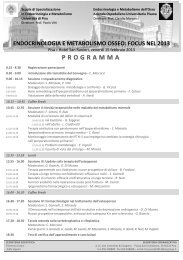You also want an ePaper? Increase the reach of your titles
YUMPU automatically turns print PDFs into web optimized ePapers that Google loves.
Ruby Blondell – Sandra Boehringer<br />
psychological identities, the butch and the fem (models that seem easily legible to a modern<br />
audience). But in our view none of these interpretations is adequate to the complexities of the<br />
dialogue, which can be properly understood only in light of its Platonic subtext.<br />
This subtext emerges most strikingly with the use of one particular word. When Clonarium<br />
reports the rumor she has heard about women in Lesbos she calls them hetairistriai. This is only the<br />
second appearance of this word in our ancient sources. The first, of course, is in Plato's <strong>Symposium</strong>.<br />
In his myth, Aristophanes tells us that the slices of the all-female primordial creature include in their<br />
number the hetairistriai (191e). What exactly does he mean? The word hetairistriai cannot be<br />
translated "lesbians" or "homosexual women," since these categories did not exist in the ancient world<br />
(where sexual behavior was not used to construct such psychological identities). Nor does it refer to<br />
all the women resulting from the splitting of the primordial female. It refers, rather to those who are<br />
attracted strongly to other women. Aristophanes gives us no further information about these women,<br />
who take their place among the fantasies and distortions licensed by his role as a comic playwright<br />
(cf. 189b). But Lucian's Clonarium defines the word hetairistria her own way: "they say there are such<br />
women in Lesbos, masculine looking (arrenopos), not willing to have it done to them (paschein) by<br />
men, but preferring to associate (plêsiazein) with women as men do". In other words, she associates<br />
sex among women with masculine attributes and sexually active behavior, suggesting gendered role<br />
reversal among the women she calls hetairistriai. But Clonarium is reporting mere hearsay. Nor did<br />
she participate in Megilla's soirée. Leaena's eye-witness account will provide a much less clear-cut<br />
picture than Clonarium's characterization of the hetairistria might lead us to expect.<br />
Let us start with the women's appearance. According to Leaena, Megilla is "terribly manly"<br />
(andrikê). What exactly does this mean? Megilla is not masculine in her general appearance or<br />
physique. The wig, when worn, is undetectable. The only physical trait that marks her as "manly"<br />
looking is her baldness--an effect that any woman could produce by shaving. Besides, she presents<br />
herself as a neaniskos, a "youth", not a mature man. The cultural mark of a neaniskos is precisely the<br />
absence of confirmed physical signs of virility, and retention of the softness and sexual indeterminacy<br />
of childhood. Megilla is, then, sometimes androgynous and sometimes feminine, depending on the<br />
presence or absence of her wig. She does not have a "masculine" physique. Note, too, that Leaena<br />
mentions no physical signs of masculinity in Demonassa, even though she is said to have "the same<br />
skills as" Megilla and both of them behave at times "like men". It is character and behavior, rather<br />
than appearance, that are emphasized throughout the dialogue.<br />
Perhaps, then, when Leaena calls Megilla "manly" she means that Megilla will play the<br />
"active" sexual role in relation to her partners and assign them the "passive" role (like the women<br />
Clonarium has heard about in Lesbos). But the larger picture does not support this model. Demonassa,<br />
despite being designated Megilla's "wife", has "the same skills" as Megilla and, like her, behaves "just<br />
like men do" in actively kissing and embracing Leaena. Leaena too takes the initiative at times. There<br />
is thus no simple active-passive or masculine-feminine reversal. Nor does the dialogue portray just<br />
one sexual act between two people. There is sex between Leaena and Megilla, sex between Megilla<br />
and Demonassa, and sex among the three women. The confusion is further fostered by Megilla's selfproclaimed<br />
identity as as a neaniskos. By claiming this identity, Megilla subverts the passive/active<br />
binary associated with conventional representations of male homoeroticism. She is both "manly" and<br />
"active", like an erastes, but the phrase kalos neaniskos clearly codes her as one who would, in a male<br />
homoerotic relationship, play the role of an eromenos. Like Plato's Alcibiades, "Megillus" is an<br />
eromenos who asserts "himself" as an erastes. At the same time, "his" pleasure described in a way that<br />
suggests the excess associated with female sexual response. Leaena presents herself, by contrast, not<br />
as experiencing reciprocal pleasure, as a woman would be expected to do, but as merely in it for the<br />
gifts she receives in return--or perhaps, like an eromenos, for the education (!).<br />
Lucian sows even more doubt by leaving us uncertain what exactly Megilla has "instead of<br />
what men have". Most scholars assume that she is referring here to an olisbos (a dildo) to "replace"<br />
the male sex organ. If so, however, her use of it does not conform to the expectations raised by the<br />
presence of such an object. The olisbos is typically represented as bringing pleasure to the person<br />
penetrated (whether it is a matter of solo or group use). But Megilla, who uses the object in question,<br />
also experiences obvious pleasure herself. Moreover neither the word olisbos nor any equivalent<br />
appears anywhere in the text. Megilla's specific practices therefore remain veiled in mystery. Rolereversal<br />
(a woman taking the role of a man) is thus not the way to explain sex between women, as<br />
shown in this dialogue. Rather, what is culturally and socially "masculine" (gender) circulates among<br />
three women without completely or permanently characterizing any one of them. The claim that<br />
Lucian is relocating sex between women into the framework of a binary active/passive relationship<br />
modelled on conventional representations of male homoeroticism is equally untenable.<br />
82




